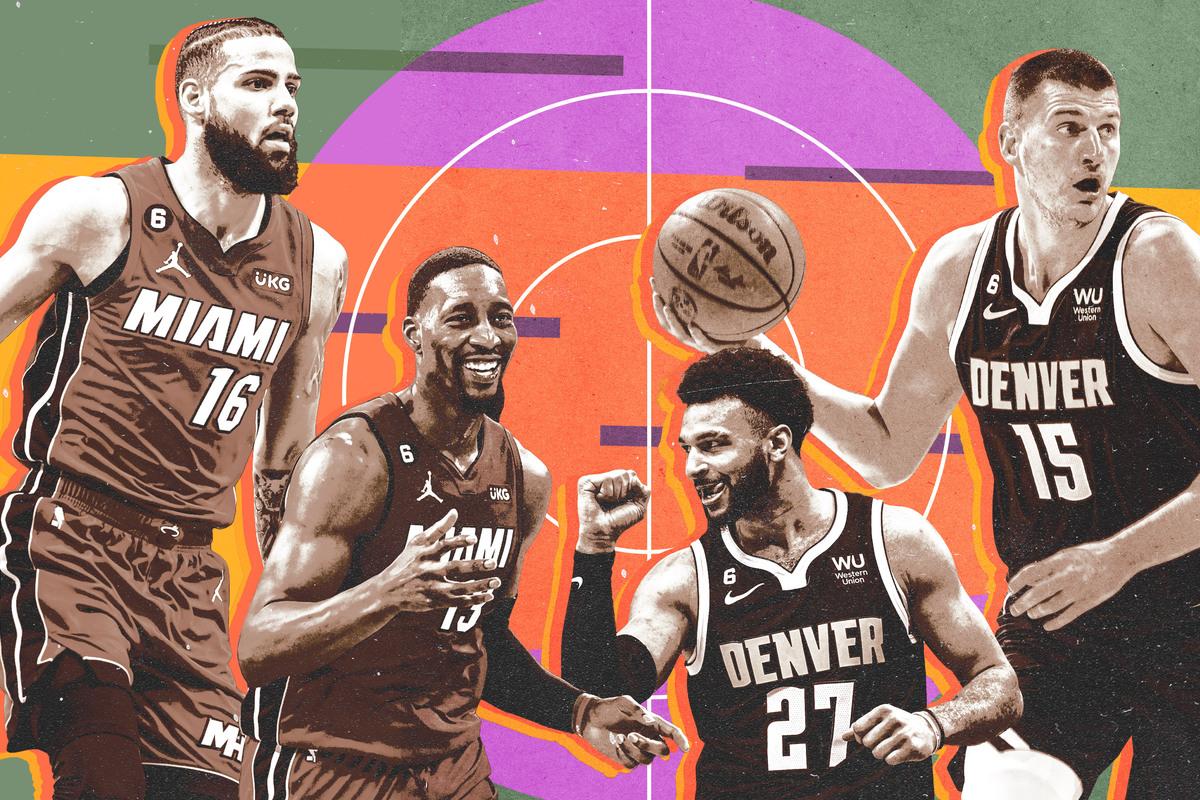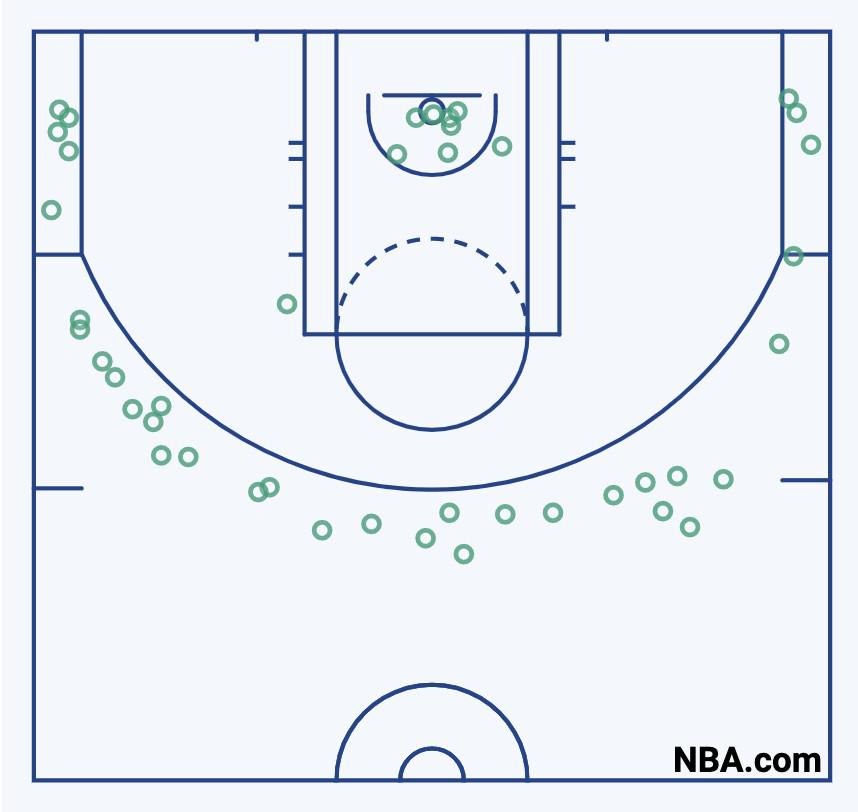
The most important number to know in order to understand the 2023 conference finals is zero. That is, zero teams have ever come back from a 3-0 deficit in an NBA playoff series—relevant precedent because the Celtics and Lakers both trail 3-0, following an exuberant weekend for the Heat and Nuggets.
Now, for only the second time in the 16-team playoff era, both conference finals have begun 3-0. (In 2015, the Cavaliers completed their sweep of the Hawks, while the Warriors closed out the Rockets in five games.) The Celtics and Lakers might still stave off sweeps this week, but the 2023 postseason seems all but assured of an improbable Heat vs. Nuggets, 8-seed vs. 1-seed final at this point.
The only negative—at least for Nuggets fans, Heat fans, and neutral fans basking in the schadenfreude of the Lakers’ and Celtics’ frustrating defeats—is a presumably lengthy wait before the Finals begin on June 1. But for now, we can analyze just how the two conference finals turned into routs, by looking at a half-dozen other numbers that tell the story of this playoff round: three that explain the Heat’s three wins, and three that explain the Nuggets’.
Miami Heat
47.8 percent
As I’ve written repeatedly throughout the past month, the most surprising aspect of the Heat’s run is how well they’re shooting. The team that led the NBA in 3-point percentage in 2021-22—en route to the East’s no. 1 seed—ranked just 27th in that statistic this season, and the now-injured Tyler Herro was the only Heat player who shot better than league average on 3s.
But the Heat scorched the nets against Milwaukee in their 8-over-1 upset in the first round, and they’ve caught fire once more against Boston. Miami made more than half its 3s in both Game 1 and Game 3, and is now at 47.8 percent overall in this series. No previous team in conference finals history has shot better than 45 percent from distance (minimum 50 attempts).
The Heat are also shooting well from 2-point range, and in their 128-102 blowout win in Game 3, they outperformed their expected effective field goal percentage—based on factors like shot location, defender distance, and shooter identity—by 17 percentage points. They now have four of the top six single-game overperformances this postseason, according to Second Spectrum, including two from the conference finals.
Best Shotmaking Games of 2023 Postseason
42.3
Jimmy Butler is the Heat’s hero, but he hasn’t needed to be quite as singularly transcendent against Boston as he did against Milwaukee. In Game 3, for instance, Butler scored only 16 points while Gabe Vincent (29 points), Duncan Robinson (22), and Caleb Martin (18) led the way.
Those three players are all undrafted—a Miami specialty—and both Robinson and Martin come off the bench, where they help form the best reserve corps in the playoffs. Heat reserves are averaging 42.3 points per game in the conference finals, according to NBA Advanced Stats—the most for any team in this round since the 2016-17 Spurs averaged 51 bench points per game while being swept. (The last team to win the conference finals with so many bench points was the 2013-14 Spurs, who averaged 49 per game. Manu!)
Robinson’s return to relevance is a surprise, given that the sharpshooter lost his 3-point touch (just 33 percent on 3s this season) and fell out of coach Erik Spoelstra’s rotation for long stretches. But Herro’s broken hand forced Robinson to step up, and he’s back with all the confidence and shotmaking bravado that he displayed in his breakout during the Heat’s journey to the Finals in 2020.
This is the Robinson whom Miami signed to a five-year, $90 million extension—all long-range moonballs and off-ball cuts, with a hilariously Moreyball-approved made-shot chart that shows precisely where he concentrates his energy on the floor.

Robinson splashed a couple 3-pointers to key a fourth-quarter comeback in Game 2, and he’s leveraged the threat of his jumper into numerous backdoor cuts for open layups as Boston stretches its defense to the perimeter. On Sunday, Robinson passed LeBron James for the most 3-point makes in Heat playoff history.
And he isn’t even Miami’s most important reserve. That would be Martin, who’s second on the team in points in this series (19.3 per game) and providing efficient two-way production as a closer in crunch time. Starter Kevin Love exited Game 3 early with an ankle injury, and Martin stepped in with no dropoff whatsoever.
Kyle Lowry is also contributing off the bench with his usual brand of clutch shooting and pesky defense. Even Cody Zeller has helped stabilize bench units when Bam Adebayo rests, and the Lowry-Zeller pick-and-roll pairing has somehow produced 1.41 points per play in the playoffs.
23
The Heat aren’t winning only because of their scoring; they’ve also prevented the Celtics, who ranked second in the league in regular-season offensive rating, from scoring at their usual clip. Boston has scored only 110.6 points per 100 possessions in the conference finals—about seven ticks below its rate in the regular season.
That decline starts with the Celtics’ two stars, who have fallen well below their standard over the past three games. Jayson Tatum has scored 26 points per game against Miami, but on subpar efficiency as he’s connected on just 25 percent of his 3-point attempts, and especially struggled in fourth quarters. Jaylen Brown looks lost, with just 17 points per game, 38 percent shooting from the field, and 10 percent shooting (10!) from 3-point range. And neither two-way All-NBA wing has played to his usual defensive level, either; Brown doesn’t have a single steal or block all series.
Perhaps worst of all, both Tatum and Brown have more turnovers (23 combined) than assists (21). Through two postseason rounds, the Celtics had the fourth-most assists per game and second-fewest turnovers of any playoff team—a crucial correction, after turnovers might have cost them the title last season.
But the Heat’s snappy, opportunistic defense, led by Butler on the perimeter and Adebayo in the middle, has transformed the Celtics offense back into a sloppy, fumbling, turnover-prone mess. One wonders just how well Miami will be able to slow down another dynamic offense in the next round.
Denver Nuggets
41.4 percent
The Nuggets are winning the conference finals because even the Lakers defense—the best in the playoffs before this round—cannot slow Denver’s offense. The Nuggets are scoring 120.9 points per 100 possessions against the Lakers, which is better than Sacramento’s league-best mark in the regular season. Denver’s offense has improved through every playoff round.
Nuggets Points Per 100 Possessions
How has Denver so thoroughly torched the defense that stymied the Warriors’ and Grizzlies’ high-octane attacks through the first two rounds? Nikola Jokic and Jamal Murray are about as unstoppable as ever—more on their partnership in a moment—but essentially the entire Nuggets rotation has contributed by taking advantage of all the space that Jokic creates.
Denver is making 41.4 percent of its 3-pointers in the conference finals—which would look impressive compared to just about any team other than the current Heat. Five different Nuggets have attempted at least 10 3-pointers in this series, and all five are shooting 40 percent or better from distance.
Nuggets 3-Pointers During Conference Finals
Unlike with Miami, though, this teamwide excellence is more in line with Denver’s regular-season performance. The Nuggets ranked fourth in the regular season in 3-point percentage (37.9), and Murray, Porter, and Caldwell-Pope—their three most frequent 3-point shooters in the conference finals—were all at 39.8 percent or better.
By comparison, the Lakers are shooting only 33.7 percent from 3 in the conference finals. Austin Reaves is on fire (57 percent on 23 attempts), but LeBron (16 percent on 19 attempts) and D’Angelo Russell (14 percent on 14 attempts) have taken the team’s next-most attempts and not done much with them.
1.67
Murray’s and Jokic’s box score stat lines are impressive enough as is: Murray is averaging 35 points per game in this series on 52/46/93 shooting splits, while Jokic has coasted to a triple-double with 27 points, 15 rebounds, and 11 assists per game.
But we can dig deeper for this exercise, and zoom in on the play that makes their partnership so special. In the Nuggets’ standard pick-and-roll set, Jokic sets a pick for Murray, a big screening for a guard. It’s extremely effective: When that pick combination leads directly to a shot in the conference finals, the Nuggets score 1.28 points per play, according to Second Spectrum. For context, the best pick-and-roll pairing in the regular season (minimum 500 screens) averaged 1.25 points per direct play.
It’s the other way around, though, when the guard sets a pick for his two-time-MVP big, that elevates this partnership—and Denver’s offense—in unique fashion. Jokic and Murray have played together for so long that they know each other’s every trick and tendency, and Jokic’s unique skill set allows them to switch their usual roles to befuddle defenses. In the conference finals, when a Murray pick for Jokic has led directly to a shot, Denver’s scored an outrageous 1.67 points per possession.
That figure comes on a small sample, to be fair, but the tape supports the conclusion that the Lakers have no idea how to stop this play. In Game 3, the Nuggets ran three inverted Jokic-Murray pick-and-rolls that led directly to a shot—and they scored eight points off them, with the Lakers looking confused about how to defend the action each time. (The first play in this montage left Adele, sitting courtside, looking confused as well.)
Two of those buckets helped give Denver a crucial cushion down the stretch—and were Jokic’s play call, evidently. “I have to [give] credit where credit is due: That was Nikola’s call,” coach Michael Malone said after the game. “He said on the bench, ‘Let’s go to this play. Let me and Jamal play the whole side of the floor, and we’ll make the right reads.’ We milked that down the stretch. Coach Jokic did a great job tonight.”
38.5 percent
The Lakers can’t stop Denver’s half-court offense, which is averaging 109.2 points per 100 plays in the conference finals, per Cleaning the Glass. (For context, the best regular-season team was at 105.)
But Denver’s also chasing extra points by pushing the pace as much as possible. That’s a logical approach because even bad teams that don’t have Jokic score more than 109.2 points per 100 plays in transition; overall, teams scored in the range of 30 more points per 100 plays in transition versus in the half court in the regular season.
NBA Offensive Performance by Possession Type
And through three games in the conference finals, Denver is running more than any team did all season long. The Lakers are taking good care of the ball, so the Nuggets aren’t sprinting after steals most of the time; instead, they’re getting out in transition on 38.5 percent of their defensive rebounds, per CtG, which is almost 10 percentage points higher than their regular-season mark and would have led the league during the season.
That concerted effort amounts to an extra handful of transition opportunities every game, which amounts to an extra few points, which amounts to, perhaps, the margin of victory in a series without any blowout wins thus far. The Nuggets have leaned into their advantages while exploiting the Lakers’ weak transition defense—and also keeping the Lakers off the offensive glass—which is emblematic of the entire conference finals round: Like Miami, Denver holds the upper hand in its matchup in both strategy and execution.


